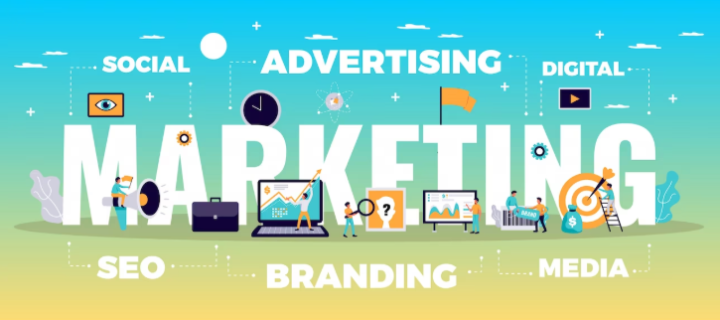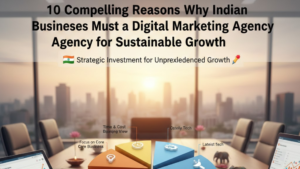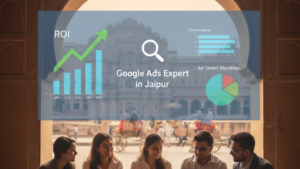Overview
In today’s fast-paced world, especially with the rise of automation and AI, every business is looking for smart ways to streamline operations and achieve rapid growth. While technology offers incredible tools, the core of success still lies in effective marketing techniques. We’re here to introduce you to 15 top modern marketing strategies designed to help your startup and established business not just survive, but truly flourish.
Here’s a comprehensive look at modern marketing strategies:
- SEO (Search Engine Optimization)
- SMO (Social Media Optimization)
- Search Engine Ads
- Social Media Ads
- Influencer Marketing
- Outdoor Advertising (Hoardings/Banners)
- Pamphlet Marketing
- Direct Sales (Door-to-Door)
- Telecalling (Cold Calling)
- Word-of-Mouth Marketing
- Guest Posting
- B2B Collaborations (In-Business Banners)
- Email Marketing
- Content Marketing
- Affiliate Marketing
1. SEO (Search Engine Optimization)
What it is: SEO is the art and science of getting your website to rank higher in search engine results for relevant keywords. Think of it as making your digital storefront easily discoverable when someone searches for what you offer. When your website appears on the first page of Google, Yahoo, or Bing, you gain significant visibility. Search engines naturally prioritize and promote content that is valuable, engaging, and authoritative.
How it helps your business: By improving your search engine ranking, you attract organic traffic – visitors who are actively looking for your products or services. This translates to highly qualified leads and potential customers.
Key principles:
- High-quality, original content: Create informative and engaging content that genuinely helps your audience. Avoid copying content, as search engines penalize duplicate material.
- Relevant keywords: Research and use keywords that your target audience is searching for.
- Long-tail keywords: These are more specific phrases (e.g., “best vegan cafes in South Delhi” instead of just “cafe”). They often have less competition and attract highly specific, high-intent traffic, leading to faster ranking.
Pro-Tip: Regularly analyze your website’s performance using tools like Google Analytics. Look for popular search queries, bounce rates, and user engagement to continually refine your SEO strategy.
2. SMO (Social Media Optimization)
What it is: SMO focuses on building and maintaining a strong presence on social media platforms like Facebook, YouTube, Instagram, LinkedIn, and X (formerly Twitter). It’s about optimizing your social media profiles and content to maximize engagement and reach.
How it helps your business: Creating engaging and shareable content for your target audience on these platforms can help you rapidly expand your network globally and cost-effectively. Social media allows for direct interaction with your audience, building community and brand loyalty.
Key principles:
- Audience-specific content: Tailor your posts to resonate with the demographics and interests of each platform’s users.
- Consistency: Regular posting keeps your audience engaged and your brand top of mind.
- Interaction: Respond to comments, messages, and mentions to foster a connection with your followers.
Pro-Tip: Content that receives high levels of shares, saves, likes, and comments tends to be amplified by social media algorithms, reaching a much wider audience faster. Focus on creating content that encourages these interactions.
3. Search Engine Ads
What it is: Also known as Paid Search or Pay-Per-Click (PPC) advertising, this strategy involves bidding on keywords to display your ads at the top of search engine results pages. Platforms like Google Ads allow you to create text, shopping, and display ads that appear when users search for specific terms.
How it helps your business: This is an incredibly powerful tactic for attracting high-intent clients. When someone searches for a product or service, they often have a strong intention to purchase. By appearing prominently at that moment, you directly capture their attention when they’re most receptive.
Key principles:
- Keyword targeting: Bid on keywords that directly relate to your offerings.
- Compelling ad copy: Write concise, engaging ad text that highlights your unique selling proposition.
- Landing page optimization: Ensure the page users land on after clicking your ad is relevant, user-friendly, and encourages conversion.
Pro-Tip: Regularly monitor your ad performance. Optimize your bids, refine your keywords, and test different ad copies to ensure you’re getting the best return on your advertising spend (ROI).
4. Social Media Ads
What it is: Social media advertising involves running paid campaigns on platforms like Facebook, Instagram, LinkedIn, and X to reach a specific audience. Unlike organic social media efforts, paid ads allow for granular targeting based on demographics, interests, behaviors, and even custom audiences.
How it helps your business: This strategy enables you to reach a highly relevant audience with tailored messages, driving various objectives like brand awareness, lead generation, website traffic, and direct sales. It’s excellent for scaling your reach beyond your organic followers.
Key principles:
- Precise audience targeting: Leverage the detailed targeting options of each platform to reach your ideal customer.
- Visually appealing creatives: Use high-quality images and videos that stand out in a crowded feed.
- Clear call to action: Tell your audience exactly what you want them to do (e.g., “Shop Now,” “Learn More,” “Sign Up”).
Pro-Tip: Experiment with different ad formats (image, video, carousel), define clear audience segments, and leverage retargeting campaigns to re-engage users who have previously interacted with your brand.
5. Influencer Marketing
What it is: Influencer marketing involves collaborating with individuals who have a dedicated following and credibility within a specific niche. These “influencers” promote your product or service to their audience, leveraging their trust and rapport with followers.
How it helps your business: By partnering with relevant influencers, you can tap into their established audience, building trust and generating authentic buzz around your brand. It’s particularly effective for reaching niche markets and fostering a sense of genuine recommendation.
Key principles:
- Relevance: Choose influencers whose audience genuinely aligns with your target market.
- Authenticity: Encourage genuine endorsements rather than overly salesy promotions.
- Transparency: Ensure both the influencer and your brand comply with disclosure regulations (e.g., #ad, #sponsored).
Pro-Tip: Focus on building long-term, authentic partnerships with influencers. Track metrics like engagement rate, reach, and conversions to measure the success of your campaigns.
6. Outdoor Advertising (Hoardings/Banners)
What it is: This traditional marketing method includes large-format advertisements placed in public spaces, such as billboards, road banners, bus shelters, and digital screens.
How it helps your business: Outdoor advertising offers widespread visibility and strong brand recall. While it might not track direct conversions as easily as digital methods, it’s highly effective for building brand awareness, especially in specific geographical areas, and reaching a broad, diverse audience.
Key principles:
- Strategic placement: Position your ads in high-traffic areas relevant to your target demographic (e.g., near major highways, commercial hubs, or specific neighborhoods).
- Concise messaging: Keep your message short, impactful, and easy to understand at a glance.
- Strong visuals: Use bold graphics and minimal text to grab attention quickly.
Pro-Tip: Pair outdoor advertising with a clear call to action that’s easy to remember or note down, like a simple website URL or a memorable phone number.
7. Pamphlet Marketing
What it is: Pamphlet marketing, or flyer distribution, involves physically handing out brochures, leaflets, or flyers to potential customers in a specific location.
How it helps your business: This method is highly effective for local businesses looking to reach a specific community or promote time-sensitive offers, events, or new store openings. It allows for direct, tangible interaction with your marketing message.
Key principles:
- Targeted distribution: Distribute pamphlets in areas where your ideal customers are likely to be found (e.g., local markets, residential areas, community events, near your physical store).
- Clear value proposition: Highlight the benefits of your product or service and include a compelling call to action (e.g., discount code, QR code to your website).
- Attractive design: Use eye-catching visuals and an easy-to-read layout.
Pro-Tip: Consider combining pamphlet distribution with an online component, such as a QR code that leads to a special landing page or discount, to bridge the gap between offline and online engagement.
8. Direct Sales (Door-to-Door)
What it is: Direct sales, often executed by a team of sales executives going door-to-door, involves in-person interaction with potential customers. It’s a highly personal approach to selling.
How it helps your business: This method allows for immediate engagement, enabling sales representatives to answer questions, demonstrate products, and build rapport on the spot. It’s particularly effective for complex products, services requiring explanation, or for building a local customer base.
Key principles:
- Thorough training: Equip your sales team with in-depth product knowledge, strong communication skills, and objection-handling techniques.
- Relationship building: Encourage representatives to focus on understanding customer needs and offering solutions rather than just pushing sales.
- Professionalism: Maintain a professional demeanor and appearance.
Pro-Tip: Provide your sales team with effective sales enablement tools, such as tablets with product demos or clear leave-behind materials, to enhance their pitch.
9. Telecalling (Cold Calling)
What it is: Telecalling, or cold calling, involves proactively reaching out to potential customers over the phone who have not previously expressed interest in your product or service.
How it helps your business: While often challenging and requiring persistence, telecalling can be effective for generating leads, qualifying prospects, and even closing direct sales, especially in B2B contexts where a direct conversation can expedite the sales cycle.
Key principles:
- Compelling script (but flexible): Develop a clear script that outlines your value proposition and key talking points, but allow for natural conversation and adaptation to the prospect’s needs.
- Active listening: Focus on understanding the prospect’s pain points and offering tailored solutions.
- Professionalism and persistence: Be polite, respectful, and persistent without being aggressive.
Pro-Tip: Focus on quality over quantity. Research your prospects before calling, and aim to qualify them for further engagement rather than immediately pushing for a sale.
10. Word-of-Mouth Marketing
What it is: This is arguably the most powerful and organic form of marketing. It relies on satisfied customers sharing their positive experiences with your business to their friends, family, and colleagues.
How it helps your business: Word-of-mouth marketing is built on trust and authentic recommendation, leading to highly qualified leads who are already predisposed to trust your brand. It fosters organic growth and significantly strengthens your reputation.
Key principles:
- Exceptional customer experience: Consistently deliver outstanding products/services and unparalleled customer service.
- Encourage reviews: Ask satisfied customers to leave reviews on relevant platforms (Google, Yelp, social media).
- Referral programs: Incentivize customers to refer new business with discounts, credits, or exclusive offers.
Pro-Tip: Make it easy for customers to share their positive experiences. Implement a clear process for gathering testimonials and encourage social media sharing.
11. Guest Posting
What it is: Guest posting involves writing and publishing articles or blog posts on other relevant websites or blogs within your industry.
How it helps your business: This strategy helps expand your reach to a new, relevant audience that might not have discovered your brand otherwise. It also establishes your brand as an industry authority and thought leader, building credibility. Furthermore, guest posts often include a backlink to your website, which is excellent for SEO.
Key principles:
- Target relevant websites: Identify reputable blogs or online publications that cater to your target audience.
- Provide valuable content: Offer unique, high-quality content that genuinely benefits the host site’s readers.
- Strategic bio: Include a compelling author bio with a clear call to action and a link back to your website.
Pro-Tip: Focus on building relationships with blog owners and editors. Offer fresh perspectives and well-researched content that aligns with their editorial guidelines.
12. B2B Collaborations (In-Business Banners)
What it is: This involves partnering with other businesses (B2B) to cross-promote each other’s services, often through mutually beneficial arrangements like placing promotional materials (e.g., banners, flyers, digital screens) inside each other’s business premises.
How it helps your business: This allows both businesses to leverage each other’s customer base, reaching a pre-qualified and often complementary audience. For example, a gym might collaborate with a health food store.
Key principles:
- Complementary businesses: Partner with businesses that serve a similar target audience but don’t directly compete with your offerings.
- Mutual benefit: Ensure the collaboration offers clear advantages for both parties.
- Brand alignment: Make sure the partner business’s values and image align with your own.
Pro-Tip: Beyond just banners, explore other collaborative opportunities like joint webinars, co-sponsored events, or cross-promotional social media campaigns.
13. Email Marketing
What it is: Email marketing involves sending commercial messages to a group of people via email. This can include newsletters, promotional offers, product updates, and personalized communications to build customer relationships.
How it helps your business: Email marketing is incredibly effective for nurturing leads, driving repeat purchases, and building customer loyalty. It allows for highly personalized communication and direct engagement with your audience, often yielding a high return on investment (ROI).
Key principles:
- Build an engaged list: Focus on obtaining opt-in subscribers who genuinely want to receive your emails.
- Segment your audience: Send targeted emails to different customer segments based on their interests or behavior.
- Compelling content: Create valuable, relevant, and engaging email content with clear calls to action.
Pro-Tip: Automate your email sequences for onboarding new subscribers, abandoned carts, or post-purchase follow-ups to maximize efficiency and impact.
14. Content Marketing
What it is: Content marketing is a strategic approach focused on creating and distributing valuable, relevant, and consistent content to attract and retain a clearly defined audience — and, ultimately, to drive profitable customer action. This includes blog posts, articles, videos, infographics, podcasts, e-books, and more.
How it helps your business: It helps establish your brand as an authority, educates your audience, builds trust, and naturally leads to higher search engine rankings and customer engagement. It’s a long-term strategy that builds a loyal audience.
Key principles:
- Audience-centric: Create content that directly addresses your audience’s questions, pain points, and interests.
- Value-driven: Focus on providing genuine value rather than just selling.
- Consistency: Regularly publish new content to keep your audience engaged and informed.
Pro-Tip: Develop a content calendar to plan your content strategy. Repurpose existing content into different formats (e.g., turn a blog post into an infographic or video) to maximize its reach.
15. Affiliate Marketing
What it is: Affiliate marketing is a performance-based marketing strategy where you pay a commission to individuals or other businesses (affiliates) for driving sales or leads to your business. The affiliate promotes your product/service and earns a percentage of the sale or a fixed fee for each successful conversion.
How it helps your business: It’s a cost-effective way to scale your marketing efforts because you only pay for results. You leverage the reach and trust of affiliates who are already connected with potential customers.
Key principles:
- Clear commission structure: Define attractive commission rates to motivate affiliates.
- Reliable tracking: Use robust affiliate tracking software to accurately attribute sales and commissions.
- Support for affiliates: Provide affiliates with marketing materials, product information, and ongoing support.
Pro-Tip: Recruit affiliates who have an audience that aligns perfectly with your target market. Build strong relationships with your top-performing affiliates.
By strategically implementing a combination of these modern marketing strategies, businesses and startups in New Delhi and across India can effectively navigate the competitive landscape, attract their ideal customers, and achieve sustainable growth in this dynamic age of automation and AI.
Which of these strategies do you think would be most impactful for your business right now?








